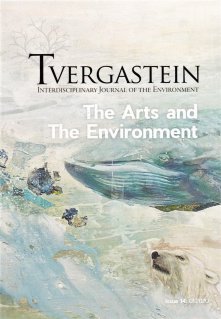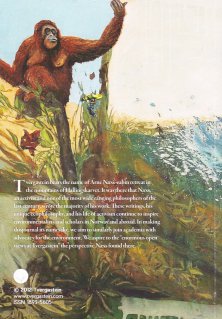Arbeidet mitt har helt fra starten av vært knyttet til natur og klimaspørsmål. Som norsk kunstner i Frankrike har jeg hatt et ben i hvert land; kontraster, grense - og identitetsspørsmål har derfor stått sentralt. Samtidig har arbeidet mitt utviklet seg i takt med jordas klimaendringer.
Ved å oppleve over lengre perioder forskjellige landskap, kulturer og klima, har geografiske og metrologiske forskjeller blitt et sentralt utgangspunkt for arbeidet mitt. Det har dermed vært naturlig å jobbe med kontraster og motsetninger via både farger og materialbruk for å uttrykke kulde/varme, tørt/vått, tynt/tykt; lys/mørke, vind/ro, inne/ute, mikro/makro osv .
Selv om jeg har valgt å integrere dyr i bildene mine kan jeg ikke anses å være dyremaler. Isbjørner og gorillaer har vært et leitmotiv for å utrykke kontraster og motsetninger som opptar meg. De er blitt stereotype symboler på ytterpunkter, og det er denne grensegangen som interesserer meg. Via media og diverse grønne kampanjer i kampen mot klimaendringene settes det fokus på nettopp disse dyrene på en nærmest klisjé-aktig måte.
L'art est un espace de liberté qui donne à voir des mondes alternatifs.
Lorsque j'ai commencé à m’exprimer en tant qu'artiste, il y a plus de 30 ans, mon travail était déjà étroitement lié à la nature et à l’environnement. Le rapport que j'ai eue avec la nature et les animaux dans mon enfance - grandissant dans une ferme à Norvège - a incontestablement contribué à me construire.
Ainsi, très tôt, j’ai pris conscience que nous ne sommes que de petits éléments dans un contexte bien plus grand. Nous mangions ce que nous cultivions, et en observant la biodiversité dans ce micromonde, j’ai pu comprendre comment tout est lié ; comment la vie se crée et se préserve, en respectant son équilibre.
Mes expériences biculturelles se reflètent dans mon travail qui a évolué avec le changement climatique et d’autres phénomènes et impacts non-naturels sur notre Terre depuis mon enfance, avec de nouvelles compréhensions et approches en cours de route. Mon travail est dans un processus continu de mutation dans une tentative de refléter les changements constants que nous vivons. Ce n'est pas le monde des animaux que j'essaie d'illustrer, mais bien au contraire: notre supériorité qui se construit par la dégradation des animaux et de la nature. La liste est longue d'empiétements et de destructions de la nature au profit de l’humain ; on le sait à court terme, mais qui ont entraîné des impacts environnementaux durables. Les affaires lucratives et cyniques telles que la poursuite des rhinocéros à des fins de "médecine naturelle" ou la chasse à l'ivoire non moins absurde ont été des thèmes récurrents. Les ours polaires et les gorilles sont devenus des symboles stéréotypés de deux extrêmes ayant un destin commun malgré leur force inhérente et latente. L'ours polaire particulièrement menacé a reçu une attention privilégiée. En tant que mammifère marin, il lie la terre et l'océan et incarne ainsi un problème mondial.
This diptych entitled Land of Welcome / Terre d'Accueil is a kind of synthesis of current topics such as recycling, plastic pollution, deforestation, boat and climate refugees. A paradise on earth is under construction. No criteria for being welcomed. They are all in the same boat. And since the captain has left the ship, an orangutan has taken over. With an outstretched arm, from the top of a solitary tree in what was once a tropical forest, the refugees are given a pleasant welcome. Some colorful birds may indicate that the forest is under reconstruction.
Land of Welcome depicts our chaotic world. Yet, hope triumphs over despair: the migrants have managed to cross the borderline; the whale is being hauled on a plastic tarpaulin instead of swallowing it...
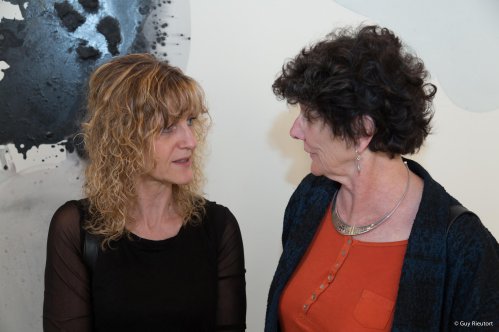
It seems to me that the artist's role should be to act like a sort of researcher - or like the philosopher - inquiring what is invisible, hidden, silenced or unexplained. Thus you will never get to the end of it, to the solution, and that is what is pushing you forward, from canvas to canvas in an almost gullible belief that you will end up in an answer.
The tactile part, the materials as such are as important as the pictorial part in my paintings; they complement one another. I like to mix techniques, to test out new methods and materials, to highlight the ambiguous features of the various animals through different use and ways: soft fur / bars of metal; light and free canvas / heavy steps and sand...
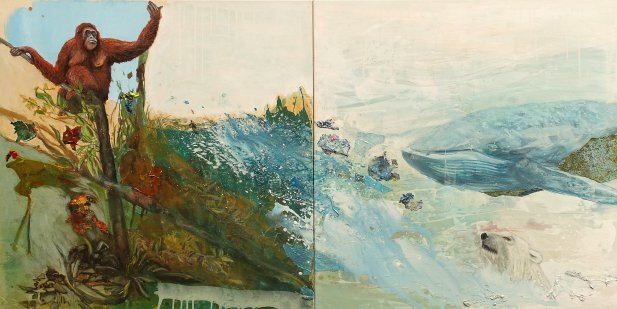
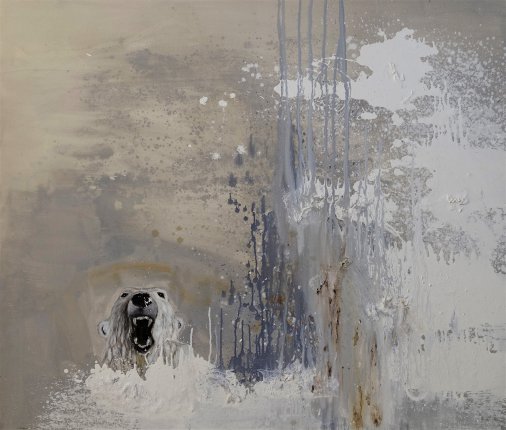
Frontpage and article about my artistic approach in Tvergastein #14, 2020
[ Norwegian Journal of the Environment ]
Avec Isabelle Autissier, présidente du WWF France
lors de l’exposition Pluri’elles, Encourager le Courage à Uzès, 2018
Les mer i Tvergastein #14, 2020
Inaudible Scream, mixed media on canvas, 200 x 170 cm, 2006
Art is a space of freedom and can open up to alternative worlds.
When I started as an artist, my work was already related to nature and environmental issues. The relationship I had to nature and animals in my childhood at a farm in Norway helped lay this foundation. Early on came the awareness that we are only small elements in a larger context.
We used to eat what we grew, and by observing our living environment we gained an understanding of how life comes into being.
My bicultural experiences are reflected in my work that has evolved alongside the earth's climate change over a 30-year period, with new understandings and approaches along the way. The work can be said to be in a continuous process of mutation in an attempt to mirror the constant changes we are experiencing.
It is not the world of animals that I try to illustrate, but quite the opposite: our superiority that is built up by the degradation of animals and nature. The list is long of encroachments and destructions of nature in favor of short-term profits that have resulted in long-lasting environmental impacts.
Lucrative and cynical businesses such as the pursuit of rhinos for "natural medicine" purposes, or the no less absurd ivory hunt have been recurrent themes. Polar bears and gorillas have become stereotypical symbols of two extremes with a common destiny despite their inherent and latent strength. The particularly endangered polar bear has been given a privileged attention. As a marine mammal it binds the earth and the ocean together and thus embodies a global issue.
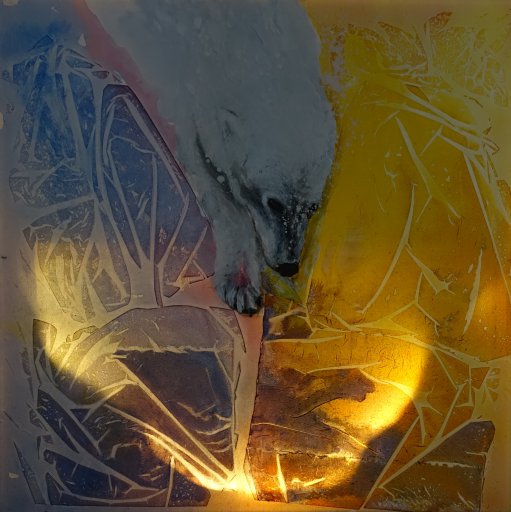
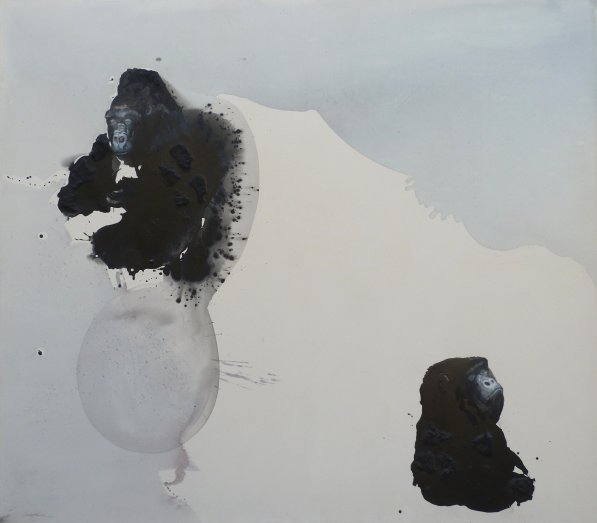
La ReNaissance, technique mixte sur toile, 200 x 175 cm, représente à plusieurs égards une toile charnière dans mon parcours. Il a été peint en 2005, 20 ans après la mort de Dian Fossey.
J'ai voulu exprimer ce flottement entre la vie et la mort, entre l'espoir et le désespoir.
Les corps des gorilles sont estropiés, peut-être violentés, mais le gorille à gauche suggère en même temps la vie et l'espoir en portant une poche placentaire dans un mouvement ascendant. Le gorille à droite reste en bas, amputé, épuisé et impuissant. Le gorille à gauche prend-t-il le relais ? représente-t-il la nouvelle génération ?
La ténacité de Diane Fossey a suscité des vocations, comme celle de Sabrina Krief qui travaille aujourd'hui pour les chimpanzés.
Je suis persuadée que toute contribution à une cause - aussi petite soit-elle - ce qui est mon cas – vaut la peine.
ReNaissance, mixed media on canvas, 200 x 175 cm, 2005
Footprint Dive, acrylics on canvas, LED, 110 x 110 cm, 2019
- Home
- About me ▾
- Works on paper ▾
-
Paintings ▾
- Polar Bears │ Large canvas
- Polar Bears │ Tipping Points │ series on canvas
- Polar Bears │ Ups & Downs │ Triptychs
- Gorillas on canvas
- 200 Gorilla Portraits
- Gorilla Family Interferences │ Triptychs
- Outlooks │ 1-in-1 │1990-2000
- Outlooks │ 2-in-1 │1990-2020
- Elephants on canvas
- Rhinos on canvas
- Lemmings
- Bees
- Marine Life │ Turtles │ Whales
- Ephemeral works ▾
- Collages ▾
- Video Tales ▾
-
Exhibition views ▾
- Espace d'art contemporain, Bédarieux, France, 2021
- Le Réservoir, Sète, France 2020
- Ephemeral exhibition: Ice Music Festival, Norway 2020
- Ancien Evêché, Uzès, France 2018
- Galleri Dalype, Oslo, Norway 2016
- Crescendo, Geilo, Norway 2015
- Château Gréoux les Bains, France 2012
- Parcours de l'art, Avignon, France 2011
- Palais de la Découverte, Paris 2007
- Chapelle des Jésuites, Nîmes, France 2006
- Articles ▾
- Contact me
my artistic approach :
Oddbjørg REINTON © 2023
